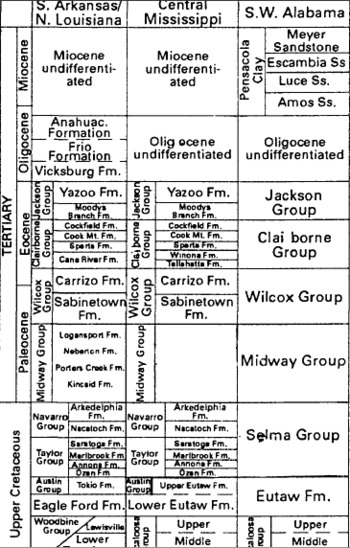Selma Group
The Selma Group is a geological formation in North America, within the U.S. states of Alabama, Mississippi, and Tennessee. The strata date from the Santonian to the Maastrichtian stages of the Late Cretaceous. The group is composed of, in ascending order, the Mooreville Chalk Formation, Demopolis Chalk Formation, Ripley Formation, and Prairie Bluff Chalk Formation. Dinosaur and mosasaur remains are among the fossils that have been recovered from the Selma Group.[1][2]
| Selma Group Stratigraphic range: Upper Cretaceous | |
|---|---|
Prairie Bluff Chalk Formation of the Selma Group exposed in Starkville, Mississippi. | |
| Type | Geological formation |
| Sub-units | Mooreville Chalk Formation Demopolis Chalk Formation Ripley Formation Prairie Bluff Chalk Formation |
| Underlies | Midway Group |
| Overlies | Eutaw Formation |
| Lithology | |
| Primary | Chalk |
| Other | Glauconitic sandstone |
| Location | |
| Region | Alabama, Georgia, Mississippi, Tennessee |
| Country | United States |
| Type section | |
| Named for | Selma, Alabama |

Stratigraphic column for the Selma
Oil was discovered in 1939 within the Late Cretaceous Woodruff Sandstone within the Selma Chalk Formation. Known as Mississippi's first oil field, the Tinsley Oil Field is located adjacent to Tinsley, Mississippi.[3]
See also
- List of dinosaur-bearing rock formations
References
- Weishampel, David B; et al. (2004). "Dinosaur distribution (Late Cretaceous, North America)." In: Weishampel, David B.; Dodson, Peter; and Osmólska, Halszka (eds.): The Dinosauria, 2nd, Berkeley: University of California Press. Pp. 574-588. ISBN 0-520-24209-2.
- Kiernan, Caitlin R. (2002). "Stratigraphic distribution and habitat segregation of mosasaurs in the Upper Cretaceous of western and central Alabama, with an historical review of Alabama mosasaur discoveries". Journal of Vertebrate Paleontology. 22 (1): 91–103. doi:10.1671/0272-4634(2002)022[0091:SDAHSO]2.0.CO;2. Retrieved 2009-02-02.
- Shelton, M.F. (1976). Braunstein, Jules (ed.). Tinsley Oil Field, Yazoo County, Mississippi, in North American Oil and Gas Fields. Tulsa: The American Association of Petroleum Geologists. pp. 239–258. ISBN 0891813004.
This article is issued from Wikipedia. The text is licensed under Creative Commons - Attribution - Sharealike. Additional terms may apply for the media files.